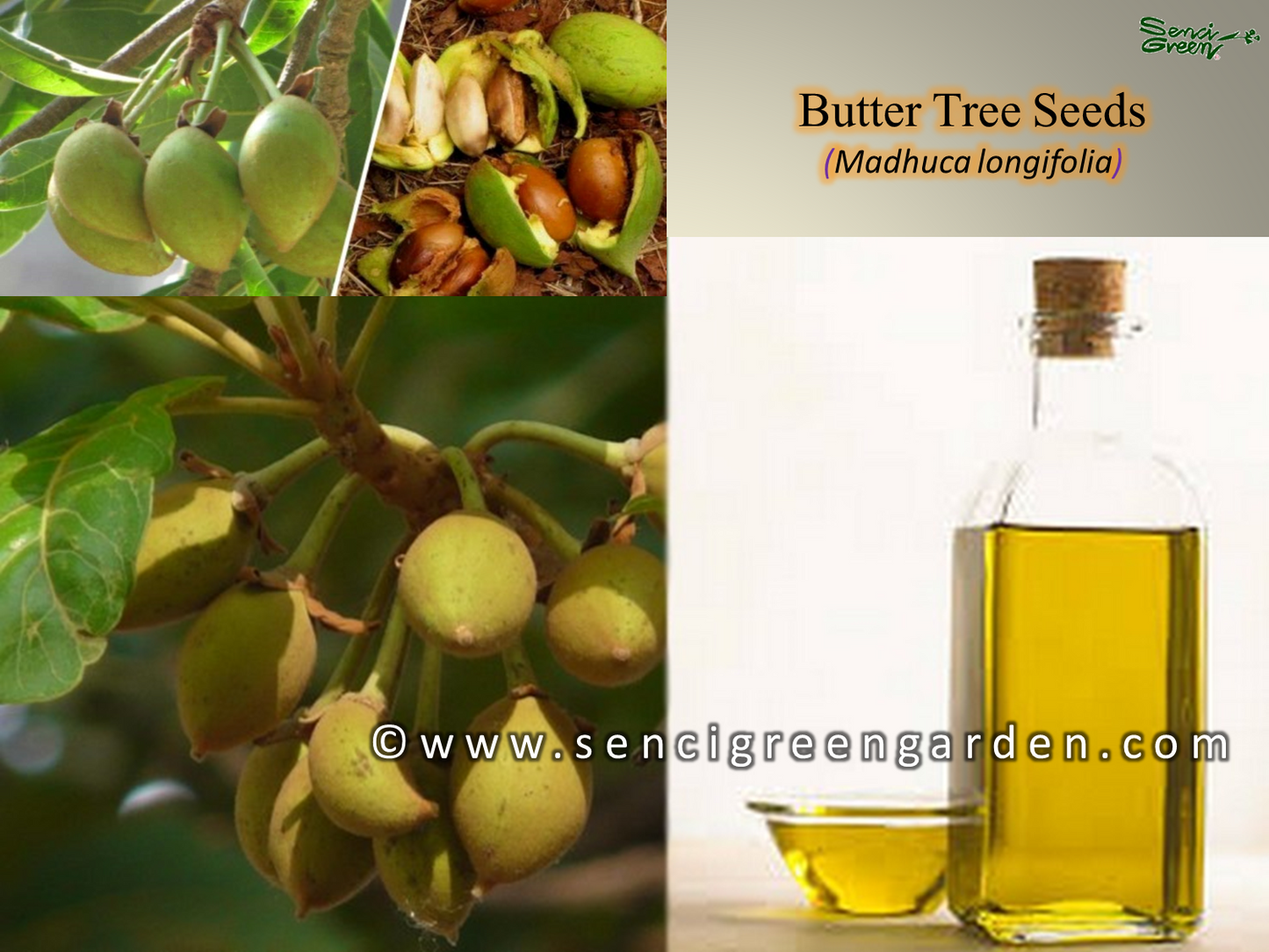Senci Green Garden
Butter Tree Seeds (Madhuca longifolia) 10 seeds
Butter Tree Seeds (Madhuca longifolia) 10 seeds
Couldn't load pickup availability
Butter Tree Seeds (Madhuca longifolia)
Mahua, or Indian Butter Tree, is one of the most important trees of India, its flowers and seed providing food as well as a livelihood for countless people on the subcontinent.
There are two known varieties, var. longifolia which occurs in southern India and parts of Sri Lanka, and var. latifolia which is more widely distributed in India. Only the latter variety is described here, its natural range extending across the north of India, from Punjab to West Bengal, and from Central India to Tamil Nadu.
It grows relatively slowly to heights of up to 18 m (60 ft), though is more commonly 10 to 15 m (33 to 50 ft) tall with a stout trunk supporting a wide-spreading rounded crown. The bark is grey, cracked and flakes off in thin pieces. On wounding, it exudes a thick milky sap.
The leaves are oval and pointed, up to 23 cm (9 in) long, crimson-red when they emerge, with age becoming dark green and prominently veined and have a thick, leathery texture. They are held in clusters at the ends of the branches and in the dry season turn yellow then fall off the tree to conserve water, leaving the branches exposed.
Flowering follows soon after leaf fall with the formation of dense clusters of hairy, rust-coloured flower buds at the tips of the branches. The buds develop into creamy-white, oval flowers up to 1.5 cm (0.6 in) long with fused, fleshy petals that do not open. They are believed to be wind-pollinated and number in their thousands on mature trees. Each morning they fall to the ground where they are eagerly sought after by people, livestock and other animals.
Fertilised flowers are followed by fleshy oval fruit up to 5 cm (2 in) long, that are green when young, becoming reddish-yellow or orange when ripe and have up to four glossy, dark brown seed inside.
Use
The flowers are edible and have a high sugar content. They fall to the ground naturally in great numbers and are either collected or left for livestock to browse. Mature trees produce up to 100 kgs (220 lbs) of flowers in a season. The collected flowers are either sun-dried and eaten, much like dried fruit, or are processed into different products, including sugar syrup, vinegar and alcohol.
Sugar syrup is made by immersing and macerating the flowers in hot water, straining off the liquid, filtering it through active charcoal and reducing it to a syrupy consistency under a slight vacuum. The resulting syrup is honey coloured with a floral aroma.
Natural yeast ferment occurs quickly in the sugar-rich flowers. Alcohol is made by steeping them in first boiled then cooled water, allowing them to ferment then distilling the resulting liquid. One tonne, 1000 kgs (2200 lbs), of flowers yields about 400 litres (106 gallons) of 95% ethanol, which is double distilled to remove any foetid odour.
The mash left over after alcohol and syrup production is mostly fed to livestock. Dairy cows fed a mixed diet supplemented with the flowers produce milk with an agreeable, nutty flavour.
The seed yield by mechanical pressing up to 60% of a non-drying oil known as 'Mowrah butter' or 'Illipe butter'. It is a viscous, pale yellow or green oil that, on refinement, has little or no colour. Considerable quantities of the seed were once exported to Europe, particularly Germany. They were processed to extract the oil, which was then refined and used to make soap and candles. Nowadays, Mowrah or Illipe butter is used as a cacao butter equivalent (CBE) to replace expensive cacao butter (from Theobroma cacao) in confectionery. The leftover seed-cake has a high saponin content, making it unsuitable for livestock feed, but makes an excellent organic fertiliser.
Mahua trees produce a medium-weight, reddish-brown wood, averaging about 740 kgs per cubic meter (46 lbs per cubic ft), with high natural resistance to rot and decay. This puts it in the durable hardwood class, suitable for indoor and outdoor construction. However, the tree is rarely felled for its wood due to the economic importance of its flowers and seed.
Health use
The seed oil is used in its native range as a laxative and the flowers as a demulcent and expectorant, prescribed in the form of a decoction for treating coughs, colds and general respiratory complaints.
The flowers and its nectar are rich in energy-giving sugars, calcium and trace elements.
Climate
Grows naturally in sub-humid to moderately humid subtropical and tropical climates, generally areas with annual lows of 17 to 25°C, annual highs of 28 to 35°C, annual rainfall of 600 to 1800 mm and a dry season of 6 to 8 months.
Growing
Performs best on rich, free-draining loam and sand soils (less well on clay soils) of a moderately acid to slightly alkaline nature, generally with a pH of 5.0 to 7.5, and on sites with full to partial sun exposure. It has poor tolerance to slow-draining or waterlogged soils and to shade conditions.
Share








